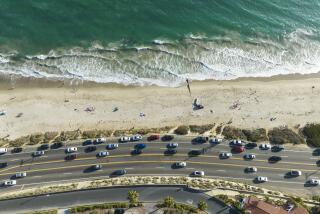‘Squeaky-Clean’ Beaches Start to Reopen 3 Weeks After Spill
- Share via
About a mile of beach between Newport and Balboa piers reopened Tuesday after a battery of biological tests found no public health threat from the crude oil that fouled long stretches of Orange County shoreline after the Feb. 7 spill off Huntington Beach.
Officials announced that several more miles of beach could be reopened to sunbathers and surfers today, a sign that the $12-million cleanup of the 394,000-gallon spill from the tanker American Trader may soon end.
“We’ve definitely turned a corner,” a smiling Huntington Beach Fire Chief Ray Picard said.
Mop-up operations have been so thorough that Picard and others say beaches in many areas are cleaner than before the spill--a bonus to beach-goers who have been banned for three weeks from 10 miles of some of California’s most popular strands. Gone are bottle caps, cigarette butts and candy wrappers. “It’s amazing,” one Newport Beach lifeguard said. “It’s never been this squeaky clean.”
State and local officials have agreed that a beach is safe for public use if the average levels of petroleum hydrocarbons--including benzene and toluene, both cancer-causing agents--are below 100 parts per million. The average for 84 samples--taken every 500 feet between the Newport and Balboa piers--was 14.3 parts per million, said Richard Wade, president of Med-Tox Associates Inc., an Anaheim-based environmental health firm hired by British Petroleum to conduct the tests.
At a press conference in Long Beach, Adm. Paul A. Yost, commandant of the Coast Guard, said the spill recovery effort stands as “a textbook case of an excellent cleanup. . . . The job is basically done. There is very little left.” Yost also said that the 811-foot oil tanker appears to have been in water too shallow when it ruptured its hull on its own anchor. Yost called the fact that soundings have never been required at tanker moorings “an oversight, a goof.”
“I think in the future the Coast Guard will take a very hard look at requiring . . . a more frequent sounding and determination of the depth,” he said.
Yost said he would like to see depth readings taken every time a large tanker uses an offshore terminal, such as the one 1.3 miles off Huntington Beach where the American Trader spilled the crude.
More to Read
Sign up for Essential California
The most important California stories and recommendations in your inbox every morning.
You may occasionally receive promotional content from the Los Angeles Times.













